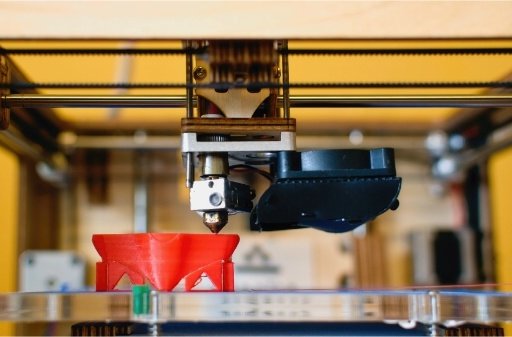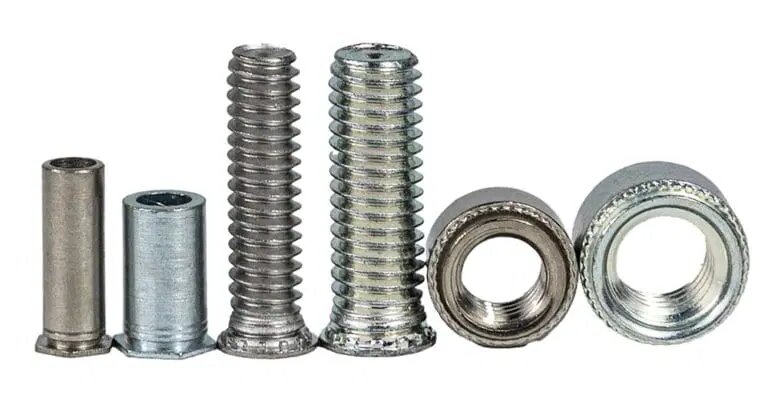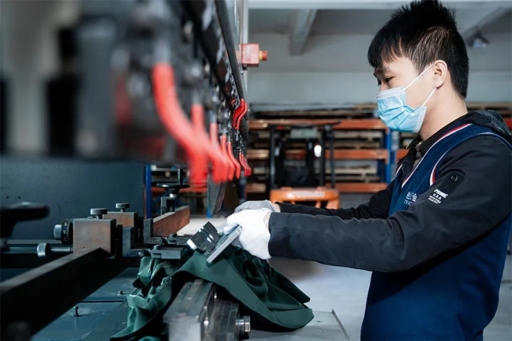Many engineers and buyers find the MOQ (Minimum Order Quantity) confusing when ordering custom sheet metal parts. It often raises questions — why do suppliers have a minimum quantity, and how does it impact cost and production?
MOQ is more than just a factory policy. It reflects the balance between efficiency, pricing, and material use. Understanding it helps you plan more effectively, reduce waste, and maximize value from each production run.
In this article, we’ll explain what MOQ means in sheet metal fabrication, why manufacturers set it, and how you can manage it effectively in your next project.
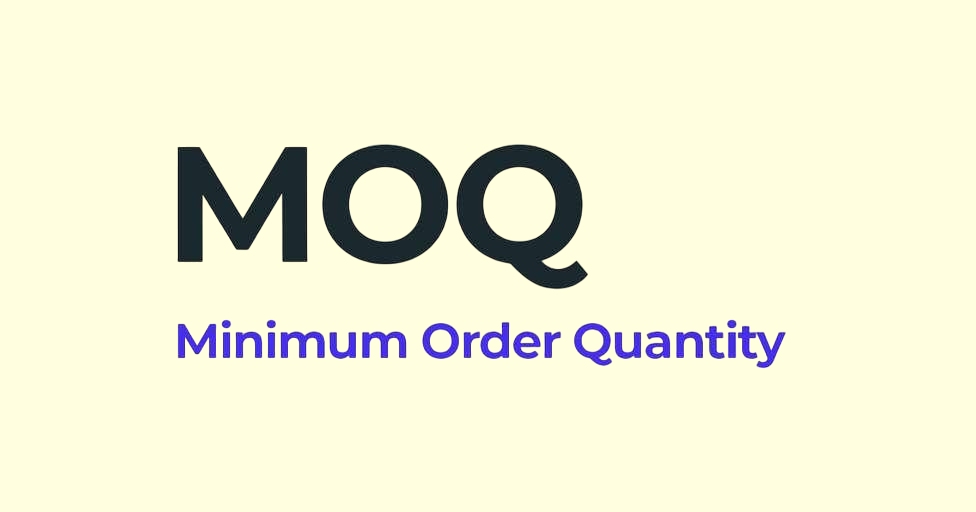
What MOQ Means in Sheet Metal Fabrication?
In sheet metal fabrication, MOQ stands for Minimum Order Quantity — the smallest number of parts a factory will produce in one order. It marks the point where production becomes practical and cost-efficient.
Every fabrication method, like laser cutting, stamping, or welding, involves setup work. Machines must be calibrated, programs must be loaded, and operators need time to prepare. These steps take effort whether you order one part or a thousand.
Setting an MOQ helps spread those setup costs across several parts. This keeps the unit price reasonable. For instance, if a press brake setup takes two hours, that time cost is shared among all the parts in the batch. Ten pieces will make each part quite expensive, but 500 pieces will lower the price per part. MOQ helps both the fabricator and the buyer maintain fair and sustainable pricing.
Factors That Influence MOQ in Sheet Metal Fabrication
MOQ in sheet metal fabrication depends on several key factors. Each element — from the material used to the complexity of the process — influences how manufacturers determine the most practical and cost-effective batch size.
Тип и толщина материала
Material plays a significant role in MOQ. Thicker or harder metals, such as stainless steel, require more time to cut and bend. This increases tool wear and machine time, so fabricators usually set higher MOQs to cover those extra costs.
Availability is another concern. Standard materials, such as mild steel or aluminum, are readily available in standard sizes, allowing for smaller orders to be fulfilled. But special alloys or uncommon thicknesses may need to be ordered in bulk from suppliers. Even if your project requires only a few parts, the factory may have to buy a whole sheet or coil, raising the MOQ to balance that extra expense.
Производственные процессы
Different fabrication processes affect MOQ in various ways. Лазерная резка is more flexible because the setup is done digitally. Once the design file is ready, production can begin right away, making small runs more practical.
However, processes such as изгиб, сварка, или отделка поверхности require more hands-on setup. For example, press brake bending requires adjustments to the tooling and test runs. Welding may need jigs to hold parts in position. Finishing processes, such as порошковое покрытие или анодирование, are typically performed in batches to ensure consistent color and texture. These extra steps make smaller runs less efficient, so the MOQ goes up.
Затраты на оснастку и наладку
Setup time and tooling are significant reasons why MOQs exist. Each machine — from laser cutters to press brakes — must be programmed and tested before full production commences. Operators spend time loading materials, checking alignment, and running test pieces to ensure quality.
This preparation takes approximately the same amount of time, regardless of whether you make 10 parts or 500. With small batches, setup costs are heavily weighed against each part. With larger batches, those exact costs are spread out, resulting in a lower price per piece.
Production Efficiency and Lead Time
MOQ is also tied to production efficiency. Factories operate most efficiently when machines run continuously without frequent stops. Constantly switching between small orders wastes time, while larger batches help keep operations steady and reduce energy use.
When operators can produce many identical parts in a single run, they reduce handling time and avoid setup errors. This consistency improves lead times and lowers per-part costs.
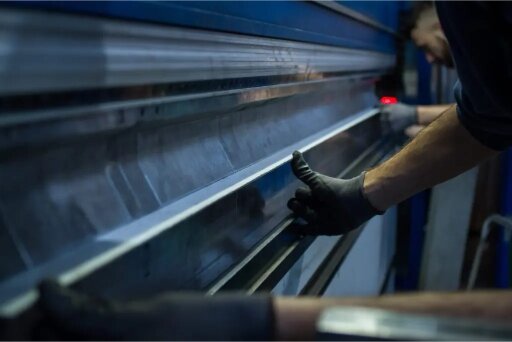
How to Reduce MOQ in Sheet Metal Orders?
Reducing MOQ is achievable with the right strategy. A mix of innovative design and close collaboration with your supplier can make small production runs more practical and affordable.
Optimize Part Design for Efficiency
Design plays a significant role in lowering MOQ. When parts share standard dimensions, materials, or thicknesses, they’re quicker to make and easier to nest on a sheet. Using standard sizes allows fabricators to rely on their existing material stock and tooling, avoiding the need for new setups.
For example, if your design uses common hole diameters or standard sheet sizes already in the factory’s inventory, the team won’t need to change tools or adjust machines. The fewer adjustments required, the lower the setup time and the smaller the MOQ can be.
Simplifying your design also helps. Reducing the number of bends, welds, or complex cutouts shortens processing time and minimizes handling. A simpler part design enables efficient production, allowing the factory to produce smaller batches without incurring additional costs.
Combine Orders or Use Shared Batches
Another effective way to lower MOQ is by combining multiple parts into one production run. If several components use the same material thickness or finish, they can be cut together from the same sheet of material. This approach spreads the setup cost across multiple parts, reducing the cost per unit.
Some manufacturers also offer shared production or batch pooling. In this setup, orders from different customers that use the same material or process are grouped. It’s a smart option for startups or companies testing prototypes, as it provides access to large-scale production without the need to purchase full sheets.
This shared model helps small businesses keep costs under control while still benefiting from the precision and consistency of professional sheet metal fabrication.
Comparing Low vs. High MOQ Scenarios
MOQ can vary depending on your project’s goals and stage. Knowing when to choose low or high quantities helps you make smarter, more cost-effective decisions for production.
When Low MOQ Makes Sense
Low MOQs are ideal for early-stage projects or highly customized parts. Startups and engineers developing new products often need only a few prototypes for testing and validation. Small batches make it easier to check fit, assembly, and performance before committing to mass production.
Low MOQs also suit custom or limited-edition products. When designs change frequently or target niche applications, smaller runs prevent overproduction and excess inventory. They also reduce financial risk if the design needs updates after testing.
Industries such as medical devices, robotics, and product development often prefer low-quantity production. In these fields, flexibility matters more than volume. A lower MOQ enables faster iterations, quicker feedback, and a shorter path from concept to market.
When High MOQ is Advantageous
High MOQs are better for stable, repeatable products with steady demand. Once the design is finalized, producing in larger batches spreads setup and programming time across more parts, lowering the cost per unit. Optimized nesting reduces material waste, and longer machine runs increase efficiency.
Bulk production also brings better pricing. Buying full sheets or coils allows the factory to secure volume discounts from material suppliers, while customers benefit from more consistent quality.
For established products, high MOQs support a steady supply chain. Companies can maintain sufficient stock to fulfill orders promptly without waiting for new production runs. This reliability is especially valuable for OEMs and manufacturers that rely on continuous assembly or scheduled deliveries.
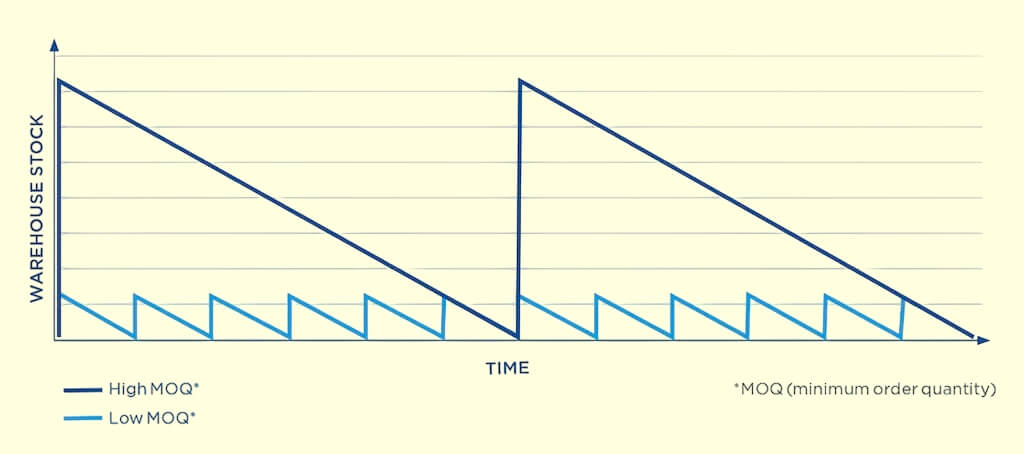
MOQ and Pricing Relationship
MOQ has a direct impact on how prices are calculated. Understanding how order size affects unit cost helps you plan your fabrication budget with more accuracy and control.
Understanding Cost Breakdown
MOQ and pricing are closely connected because every fabrication job includes both fixed and variable costs. Fixed costs cover setup, programming, and machine calibration — these don’t change whether you make 10 or 500 parts. Variable costs include material, machine time, finishing, and labor, which increase as production grows.
In small batches, fixed costs are divided among fewer parts, which raises the unit price. For example, if a laser cutter and press brake take two hours to set up, the setup cost remains the same regardless of the number of pieces ordered. When production volume increases, those setup hours are spread over more parts, and the per-unit cost drops sharply.
Material usage also influences pricing. Large metal sheets leave small gaps between cut parts, creating scrap. With higher quantities, nesting becomes more efficient and reduces waste. That efficiency brings additional savings that appear in the final cost.
The MOQ–Unit Cost Curve
If you chart the order quantity against the price per unit, the line curves downward. At small amounts, the unit cost is high because setup and handling make up the majority of the expense. As the order size increases, the unit cost decreases rapidly, then levels off once setup becomes a relatively small portion of the total production time.
This curve explains why suppliers set an MOQ. It marks the point where production becomes practical and cost-effective. Below that threshold, it’s challenging to cover setup and labor costs without increasing prices.
For buyers, knowing this relationship helps with planning and negotiation. Ordering just a bit above the MOQ often delivers much better value. For instance, increasing an order from 50 to 100 units can lower the per-unit cost enough to offset the extra material expense.
Ready to start your next sheet metal project, but unsure about MOQ or pricing? Our team can help you find the most cost-effective approach without sacrificing quality. Upload your drawings or share your project details, and our engineers will provide a free DFM review along with a customized quote.
Часто задаваемые вопросы
How can I reduce MOQ when ordering custom parts?
You can lower MOQ by simplifying your design, using standard materials, and aligning your part dimensions with the fabricator’s existing tooling. Combining multiple parts into a single production run or selecting a manufacturer that specializes in low-volume fabrication can also be beneficial.
Why do manufacturers set a high MOQ?
High MOQs help cover fixed setup costs and maintain workflow efficiency. Every job requires programming, calibration, and inspection before production starts. Larger batches make it easier to spread these costs across more parts, keeping prices stable while reducing waste and downtime.
Does the MOQ affect lead time and pricing?
Yes. A higher MOQ usually lowers the price per part but may increase total production time due to the larger batch size. Smaller MOQs can shorten the turnaround time for prototypes or urgent jobs, but each unit may cost more because setup and material costs are divided across fewer units.
Can Shengen handle small batch orders?
Yes. Our team supports both prototype and small-batch production runs. We utilize flexible setups, efficient nesting, and automated systems to produce high-quality parts at competitive pricing, even for small quantities.
Привет, я Кевин Ли

Последние 10 лет я занимался различными формами изготовления листового металла и делился здесь интересными идеями из своего опыта работы в различных мастерских.
Связаться

Кевин Ли
У меня более десяти лет профессионального опыта в производстве листового металла, специализирующегося на лазерной резке, гибке, сварке и методах обработки поверхности. Как технический директор Shengen, я стремлюсь решать сложные производственные задачи и внедрять инновации и качество в каждом проекте.

